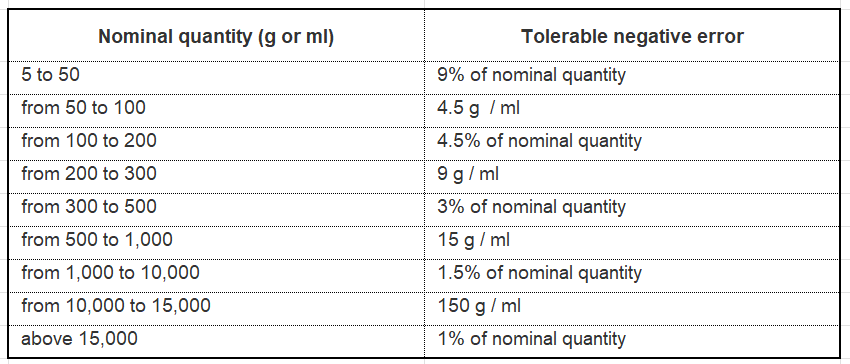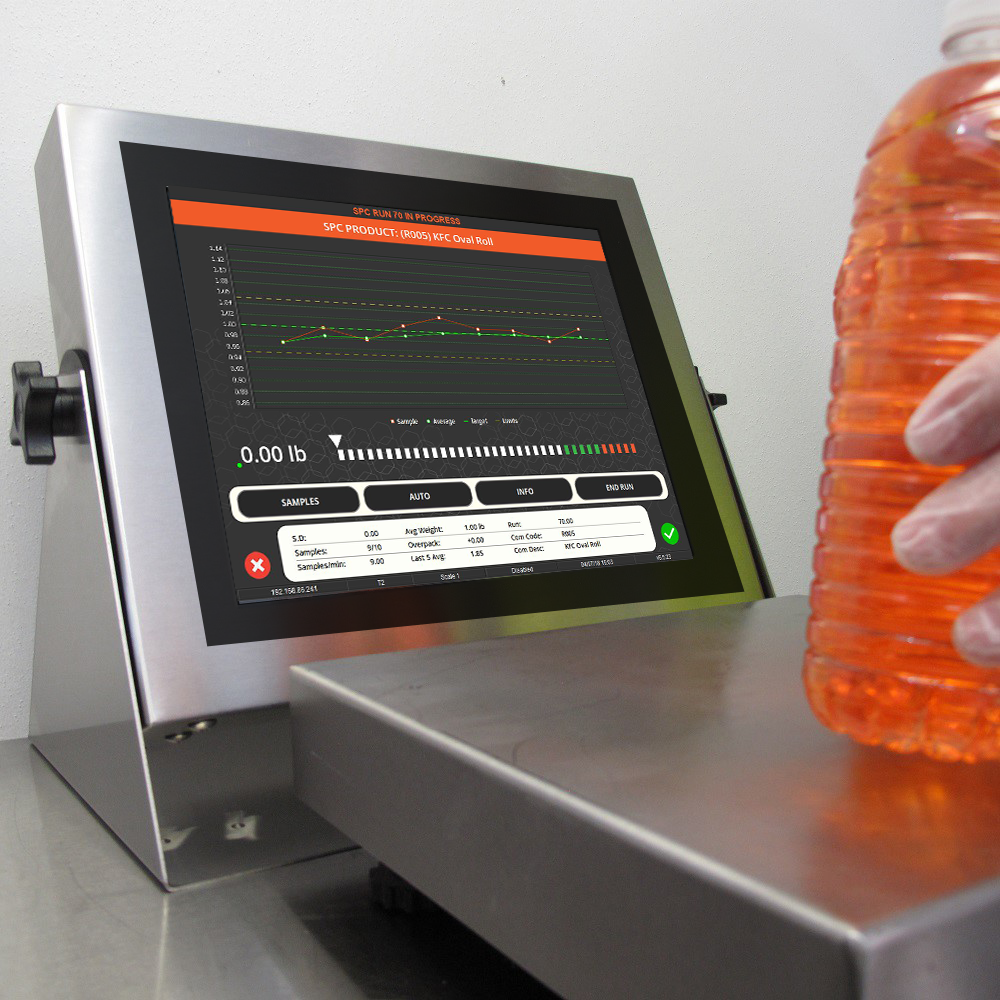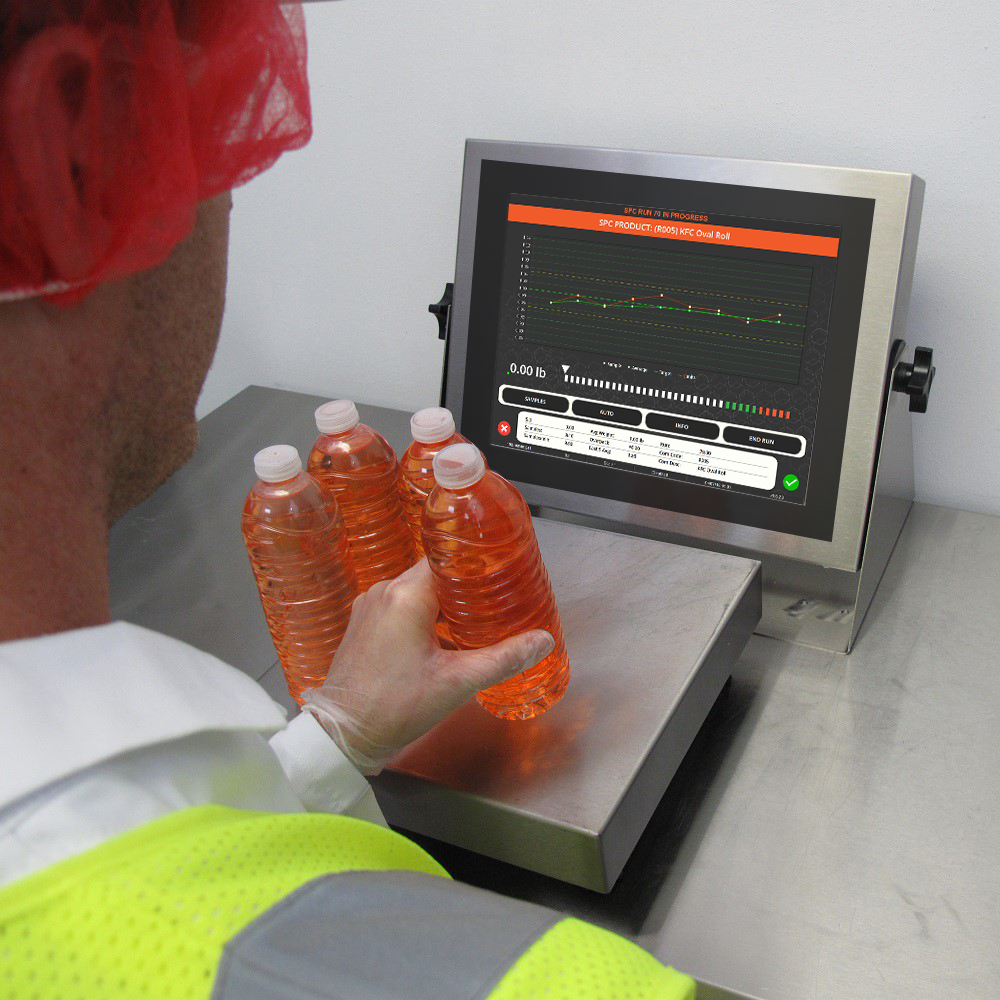
- Home
- Average Weight
- Average Weight System
Average Weight

Average Weight System
This white paper is intended to be used as an overview of the average weight legislation (Europe) and how average weight systems can help customers comply. It’s focused on the activity and actions of the packers themselves and how packaged products are marked and managed.
Note – Following Brexit and the withdrawal of the United Kingdom from the European Union, It is not yet known whether or not the legislation will remain in the United Kingdom, but we’ll be sure to update this page with new information as it arises. This guidance is for England, Scotland & Wales. Outside of Europe, the rest of the world uses the minimum weight system and monitors using SPC (statistical process control). Both systems have their pro’s and cons but the legislative for the countries being sold into determines the control system for use.
Contents
- What is a package?
- The three packers’ rules
- Tolerable negative error
- Required checks
- Average Weight System Equipment
- Actual content of packages
- Tare weights
- Quantity control systems
- Keeping records
- Markings
- Importers and average quantity
- Further information
- Penalties
- Key legislation
The ‘average weight system’ covers packaged goods that are sold by weight or volume and applies to both foodstuffs and non-foodstuffs on offer for sale.
The Regulations that cover the average weight system – the Weights and Measures (Packaged Goods) Regulations 2006 – control the overall average quantity of batches of packaged goods. They apply to packages that are made up without the customer being present, intended for sale in pre-determined constant quantities, by weight or volume. They do not apply to ‘catchweight’ items where the quantities within packages vary – for example, prepacked cheese where the price you pay is dependent on the weight of each individual item.
The controls apply both to traders making packaged goods and those importing them.
The effect of these Regulations is to ensure that ‘on average’ packaged goods contain the declared weight or volume of goods, which helps to increase customer confidence in the stated quantity, whilst confirming and defining acceptable tolerances to the variations in quantity inherent in packing processes.
What is a package?
A product plus its container becomes a package when they are combined without the purchaser being present (usually in a manufacturing environment) and thus the quantity cannot be altered without the container being opened or changed.
Very small items of less than 5 g or 5 ml, or large items of more than 25 kg or 25 l, are excluded from these Regulations but the quantity still needs to be at least that declared. Also excluded are goods sold by length or number. If you are in doubt about the product you are packing or importing please contact your local trading standards service for specialist advice.
The three packers’ rules
A batch of packaged goods must, at the time of production, comply with the following three rules:
- rule 1: the actual contents of the packages must not be less, on average, than the nominal quantity (the weight or volume that is marked on the packages)
- rule 2: the proportion of packages that are below the nominal quantity by a defined amount – the ‘tolerable negative error’ or TNE – must be less than a specified level, in general no more than 2.5%
- rule 3: no package should be below the nominal quantity by more than twice the TNE
Tolerable negative error
The following is a table of the tolerable negative error (TNE) values that you should use when complying with the three rules.

Required checks
Packers have a duty to carry out sufficiently rigorous checks to ensure that all three of the packers’ rules are met. This means you should establish a system that:
- is formalised and controls the production process
- sets up effective sampling and checking plans
- stipulates an appropriate target quantity
- controls limits
- uses and maintains appropriate equipment for checking
- trains staff
- keeps appropriate records
You have a duty to ensure that the quantity of product in packages meets the requirements of the three rules by either:
- measuring the content of each package using suitable equipment
… or
- checking statistically-selected samples of packages from the production using suitable equipment and keeping records of the results
Importers of packaged goods into the UK should refer to the ‘Importers and average quantity’ section below for an outline of their responsibilities.
Average Weight System equipment
The equipment used to carry out the checks must be suitable for the use to which it is put. This means that it should have a reasonable degree of sensitivity and accuracy (measuring to 0.2 units of the TNE for the package you are producing) and be suitable for the environment in which it is used.

For example, a 200 g nominal quantity package is permitted a TNE of 9 g; therefore 0.2 x 9 g = 1.8 g. In practice this would mean an instrument with a scale interval of 1 g would be suitable to either make up the packages or make checks on them.
Equipment must be calibrated and accurate and details of any repairs / alterations must be retained. Ask your local trading standards service for advice on specific equipment.
Actual content of packages
The actual content of a package (the net weight or volume) is the total gross weight of the package (package plus contents) minus the weight of the package.
Note: it is common practice when packing liquids to check the actual quantity of the goods in packages by weight – instead of measuring the volume – by calculating the equivalent weight using the following equation: volume = mass divided by density.
Tare weights
The weight of the package without the contents is known as the ‘tare weight’. Tare weights may be assumed to be constant if the variation in packaging weight is within acceptable limits, in which case the actual content of the packages is easy to determine by simple subtraction.
However, where the tare weight varies from pack to pack, an allowance must be made for this by establishing the heaviest weight that a package might be and adjusting the target weight of the package accordingly.
If packages cannot be guaranteed to be of a consistent weight, final checks on packages will have to be carried out by ‘destructive testing’, which involves opening packages in order to determine their actual quantity by weighing or measuring the contents. In order to avoid destructive testing you should specify to your packaging material supplier that variability in packaging weight must be sufficient so that gross weighing and simple subtraction of a standard tare weight can be employed.
For more detail and advice on ensuring consistent tare weights you should contact your local trading standards service.
Average Quantity Systems
The average requirement rule (packers’ rule 1) is most critical when the packing process variability (standard deviation) is always less than 0.5 TNE of the product.
When the process variability exceeds 0.5 TNE, then target quantity (the amount you set your filling machine to fill each package with) must exceed the declared quantity so as to comply with the three packers’ rules.

If you test fewer than 50 items in a production run then a sampling allowance must be added to the target quantity – that is, increase the fill quantity. A production run is the time taken to produce 10,000 packages (with a minimum of one hour and a maximum of one normal day). Different products demand differing levels of checking and testing.
For more detail and advice you should contact your local trading standards service.
Keeping records
If you are checking packages by statistical sampling, you must make records of the checks you have carried out. These records must show that you have complied with the three packers’ rules. It is recommended that, as a minimum, you should record the product, the batch number, the date, the number of packs in the batch, the number checked and the results of the check.
A record must also be made of the corrections and adjustments that the checks have shown to be necessary. The records must be kept for 12 months from the time the packages leave your possession or the shelf life of the product, whichever is the earliest.
Markings
Required markings need to be easily legible and visible under normal conditions of presentation. This means taking into consideration use of shade and contrast. Packages must be marked with the following:
- a statement of the nominal quantity. This statement must be in metric and the size of the marking is prescribed – for example, for a 500 g pack the marking must be at least 4 mm high
- your name and address. Alternatively you may give the name and address of the business who asked you to make the packaged goods on their behalf
One way to ensure the visibility requirement for markings is met in normal conditions of presentation is to place the markings on the front, or possibly the top, of the container. Most average weight systems will handle the marking as part of a print format symbol.
If you are packing foodstuffs within the scope of Regulation (EU) No 1169/2011 on the provision of food information to consumers, remember that the name of the food and the net quantity (weight or volume) must appear in the same field of vision.
In addition, foods that are packed in a liquid medium must be labelled with both the drained net weight and the net weight of the food. If packed in an oil medium this information is voluntary.
You may voluntarily mark the packs with the E-mark, but only on packages of at least 5 g or 5 ml and not exceeding 10 kg or 10 l. It must be at least 3 mm high, indelible, easily legible and appear in the same field of vision as the statement of quantity. The E-mark indicates that the product has been packed using the average system.

The E-mark acts as a metrological passport for goods sold throughout the European Union (EU).
If exporting to the EU, the importer there will be responsible for ensuring that the packs meet the requirements of the average quantity directive (Directive 76/211/EEC on the approximation of the laws of the Member States relating to the making-up by weight or by volume of certain prepackaged products). UK producers may get asked to provide the ‘necessary guarantees’ that the packs are in compliance with the Directive.
WELMEC 6.13 provides guidance on what evidence an EU importer may look for.
Importers and average quantity system
If you import goods into the UK you are responsible for ensuring that the packs comply with the three packers’ rules and that they are marked correctly. However, you may obtain and keep suitable documents from the actual packer (before the packages leave your possession) that provide sufficient evidence to show that the packages comply with the quantity requirements. Average Weight Systems and Average Weight Software can reduce the burden considerably by handling the calculations and alerting operators of non conforming products.
The person providing the documentation has to be of a suitable status (for example, an accredited test laboratory or national metrology service) and the information it contains should be validated.
Until 31 December 2022, if a pack is imported into the UK from an EU Member State, the contact details of the UK importer do not have to be shown on the label as long as the contact details of the EU packer or importer are present.
Average Weight Systems FAQ’s
What is an average weight system? An average weight system is designed to ensure that the weight or volume of packaged goods is on average not less than the declared quantity on the packaging. This system is crucial for maintaining customer trust and confidence in the consistency of the product quantity.
What are the key regulations for average weight systems? The principal regulations governing average weight systems are the Weights and Measures (Packaged Goods) Regulations 2006. These regulations focus primarily on ensuring that the average quantity of packaged goods is not less than what is declared on the package.
Do average weight systems apply to all packaged goods? Average weight systems are applicable to goods sold by weight or volume. However, they exclude very small items that are less than 5 grams or milliliters and large items that are more than 25 kilograms or liters. They also do not apply to goods sold by length or number.
What are the three packers’ rules in average weight systems? The three packers’ rules include ensuring that the average content of packages is not less than the nominal quantity, the tolerable negative error is within specified limits, and there are constraints on the maximum allowable shortfall in individual packages.
What is Tolerable Negative Error (TNE) in this context? Tolerable Negative Error, or TNE, is a crucial concept in average weight systems. It defines the acceptable level of negative deviation from the nominal quantity of packaged goods, ensuring fair practice and consumer protection.
What are the responsibilities of packers under these regulations? Packers have several responsibilities under these regulations. They must perform regular checks to ensure compliance with the three packers’ rules, using appropriate and accurate equipment, and adopting suitable methods for these checks.
What equipment is needed for average weight system checks? The equipment required for conducting average weight system checks needs to be sensitive, accurate, and suitable for the specific packing environment. It is essential for packers to calibrate and verify the accuracy of this equipment regularly.
How is the actual content of packages determined? To determine the actual content of packages, the total gross weight of the package is measured and then adjusted by subtracting the weight of the packaging material. This process may involve adjustments for variable tare weights in some cases.
What are the requirements for quantity control systems? Quantity control systems are required to ensure compliance with the packers’ rules, particularly in situations where variability in the packaging process can affect the quantity of the product in each package.
What records must packers keep? Packers are required to keep detailed records of all checks carried out, the results of these checks, and any adjustments made to the packaging process. These records should be retained for at least 12 months or for the shelf life of the product, whichever is longer.
What markings are required on packages? Packages must include certain markings that are visible and legible. These markings typically include the nominal quantity of the product and details about the packer or importer. In some cases, the ‘e’ mark is also included to indicate compliance with European regulations.
How does Brexit affect these regulations? The impact of Brexit on these regulations, which have their origins in EU law, is still to be fully clarified. Changes, if any, to the UK’s approach to these regulations post-Brexit are anticipated but not yet fully known.
What is the difference between average weight and minimum weight systems? The key difference between average weight and minimum weight systems lies in their focus. While average weight systems concentrate on ensuring that the batch average meets or exceeds the nominal quantity, minimum weight systems ensure that each individual package meets a minimum standard.
How does Statistical Process Control (SPC) relate to these systems? Statistical Process Control, or SPC, is used in conjunction with these systems to monitor and control the packing process. SPC helps in maintaining the quality of the packaging process and ensuring compliance with the set regulations.
What are the penalties for non-compliance with these regulations? The penalties for non-compliance with these regulations can vary depending on the jurisdiction. They can include fines and legal action, especially in cases of significant deviations from the stipulated standards.
Can these systems be integrated with existing manufacturing processes? These systems are designed to be flexible and can be integrated with various manufacturing and packaging processes. This integration helps in maintaining quality control and ensuring compliance without disrupting existing workflows.
Are there any special considerations for food packaging? For food packaging, there are often additional labeling requirements. These might include the need to name the food and display the net quantity in the same field of vision, among other specific requirements.
How do importers ensure compliance with average quality systems? Importers are responsible for ensuring that the packaged goods comply with the three packers’ rules and are correctly marked. This often involves relying on documentation and assurances from the packers.
What are the benefits of using an average weight system? The use of an average weight system brings several benefits. These include increased consumer trust, compliance with legal requirements, and improved quality control in the packaging process.
What support is available for implementing these systems? For companies looking to implement these systems, there is support available from various sources. This includes advice from local trading standards services and professional providers of average weight systems and software. These resources can help in understanding the regulations and ensuring compliance.
North America
SG Systems LLC
PO BOX 670056, DALLAS, TX 75367-0056
Phone: +1 214 819 9570
Contact us here
United Kingdom
SG Systems Europe Ltd
Suite 3 Walton Summit Centre, Green Place, Four Oaks Rd, Preston, PR5 8AY
Phone: +44 (0) 114 349 1480
Contact us here
Australia
Wedderburn
101 Williamson Road, Ingleburn NSW 2565
Phone: +61 2 9426 1800
Contact us here
Europe
SG Traceability Systems Ltd
31-32 Greenmount Office Park, Harolds Cross, Dublin D6, Ireland
Phone: +44 (0) 114 349 1480
Contact us here
Rest assured, we value your privacy and are committed to keeping your data safe. By clicking "Continue with recommended settings," you're giving us permission to use cookies. Of course, you're in control – feel free to adjust your cookie settings anytime in our Privacy Preferences.
